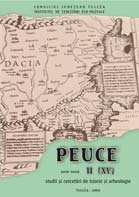Câteva particularităţi regionale ale fibulei de schemă tracică
Some regional peculiarities of the Thracian shape fibula’s typology
Author(s): Dragoş MăndescuSubject(s): Archaeology
Published by: Institutul de Cercetari Eco-Muzeale Tulcea - Institutul de Istorie si Arheologie
Keywords: Late Iron Age; Fibulae; Thracians
Summary/Abstract: In the paper are discussed three situations in which unitary groups of fibulae are characteristically for a certain territory, usually a limited one, between the 5th and the 3rd century BC. The first group is constituted by fibulae with vertical foot and flat bow. This type of fibula was discovered in the extreme East of the Thracian shape fibula’s diffusion area, in the proximity of the Black Sea’s coast. This group is dated for the middle of the 4th century BC. The second situation is that of the fibula with vertical foot and thick conical end. The main zone of diffusion is the Isker middle valley, but these fibulae diffusion area will be enlarged, because of the cultural diffusion, from the Southern Moldavia to Vardar valley and Macedonia and Marica valley, at the South of Balkans Mountains. The third group is that of the fibulae with S shaped foot and whit thick and beveled bow. This group is specific for the Central Moldavian Plateau, where international has a relative short evolution in the middle and in the second half of the 3rd century BC. The presented peculiarities are important for the illustration of the stylistic peculiarities in the carrying out of the Thracian shape fibulae and in the same time the existence of the traditional conservative workrooms, whit a rigid and slow evolution.
Journal: Peuce (Serie Nouă) - Studii şi cercetari de istorie şi arheologie
- Issue Year: II/2004
- Issue No: 2
- Page Range: 41-48
- Page Count: 8
- Language: Romanian

